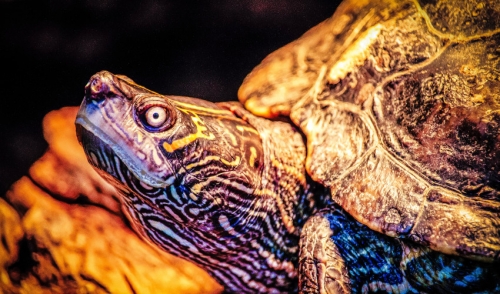{article.name}
Turtle Shell Care

- Share this:
- Share on Facebook
- Pin on Pinterest
- Tweet on Twitter
A turtle’s shell is a critical part of its anatomy, and the shell needs proper care to keep your turtle healthy. Understand the shell and how to care for it safely and effectively is essential for every turtle or tortoise owner.
What Is a Turtle’s Shell?
The shell of a turtle is more than just a covering, it is part of the animal’s skeleton and is made up of fused bones, including a number of ribs, the spine and the breastbone. The back of the shell is called the carapace, and the belly of the shell is called the plastron. Blood vessels and nerves run through the shell, and it protects the turtle’s vital organs. The bones of the shell are covered with a thick layer of skin and hard layers of keratin, the same protein found that makes up hair and fingernails. These outer layers of keratin, called scutes, will be shed as the turtle grows and new scutes are formed, and they protect the turtle from bruises and scrapes. A turtle does not ever completely shed its shell, however, and cannot be removed from its shell.
Problems With Turtle Shells
Just as other animals can develop problems with their fur and skin, turtles can develop problems with their shells. Shell rot is caused by bacterial or fungal infections. Uneven growth of the scutes can cause pyramiding of the shell, which is a deformed shape, and shells can be cracked, split, chipped or broken just as bones can be. Symptoms of turtle shell problems include…
- Pits, divots or soft spots in the shell
- Visible breaks or splits
- Red or off-color tinges on the shell
- Uneven flaking of the scutes
- A slimy coating that is not algae
- Harsh or strong odors
- Blood or discharge from a break or crack
Turtle shell problems can have many causes, from improper care to a poor diet to accidental injuries. Lack of calcium, a dirty environment, inadequate sunlight and excessive moisture can also cause irregularities in a turtle’s shell. When problems are noticed, it is important to take your turtle to the veterinarian right away for proper diagnosis and treatment.
Caring for Your Turtle’s Shell
Fortunately, it is easy to provide good turtle shell care to keep your reptile friend healthy, and good general turtle care minimizes the risk of shell problems.
- Provide a Proper Habitat
Different types of turtles require different living conditions. Be sure your turtle has enough space to roam and explore in its home and that its tank or cage is kept at the right temperature and humidity for the turtle’s needs.
- Avoid Obstacles or Hazards
Turtles can get into more trouble than many pet owners realize, and it is important that your turtle cannot get stuck in tight spaces, fall or have anything accidentally fall on it that may damage its shell inside the tank or cage.
- Keep Living Space Clean
Dirty bedding, rotting food and unclean water can all harbor bacteria that can infect a turtle’s shell. Clean the tank or cage regularly, discard uneaten food and wipe down food and water dishes every day to protect your turtle from infections.
- Provide a Healthy Diet
Different turtles have different dietary needs, and you should research what foods are best for your turtle or tortoise. Offer different foods to keep your turtle healthy, and include vitamin, mineral and calcium supplements in the diet as necessary for good nutrition.
- Provide Adequate Sunlight
Turtles need ample sunlight for healthy shells, and daily doses of sunlight are essential for a healthy turtle. UV lights or tank lights can be useful substitutes or supplements, and be sure your turtle has a comfortable basking rock so they can take advantage of sunbathing time.
- Keep Your Turtle Safe
Always take great care when your turtle is out of its tank or cage, keeping it safe from rambunctious pets, unexpected hazards or unsafe handling. Even a small fall or drop can hurt a turtle, so always handle these reptiles carefully to protect their shells.
- Inspect Your Turtle’s Shell
The sooner you notice any problems with your turtle’s shell, the sooner you can take steps to correct those problems and keep your pet healthy. Look closely at your turtle’s shell every week to notice any unusual changes, and give them regular vet checkups for expert care.
By providing proper turtle shell care, you can minimize the risk of any problems that can hurt your turtle or tortoise. If problems do occur, however, it is important to be patient. Turtles can heal but it is a slow process that requires dedicated care to be sure they get the right treatment. Check with your veterinarian regularly to keep your turtle’s shell in good shape, and your pet will have a long, happy, healthy life.
Special Offers

We offer FREE home delivery—no minimum purchase required! ( Print This )
Company Events
We currently do not have any events scheduled.

Comments